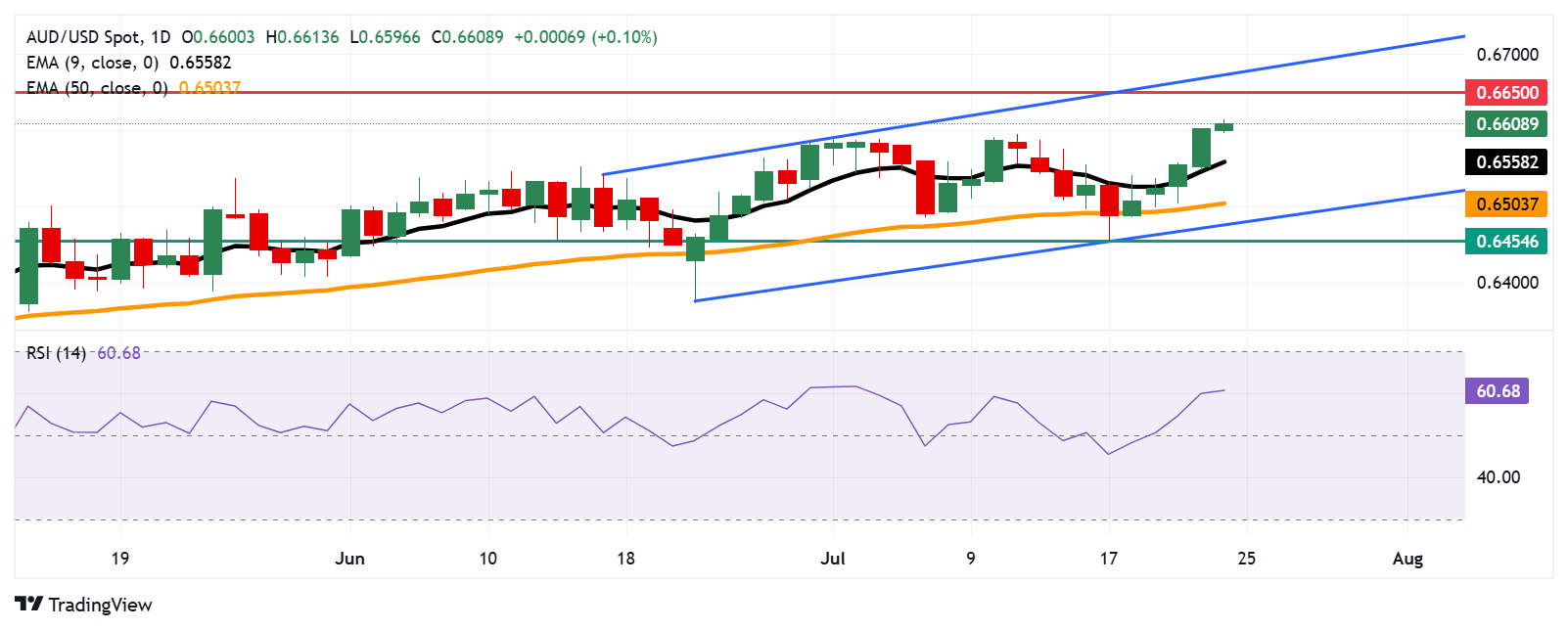Created
: 2025.07.24














![]() 2025.07.24 11:19
2025.07.24 11:19
The Australian Dollar (AUD) advances against the US Dollar (USD) on Thursday, extending its gains for the fifth consecutive day. The AUD/USD pair is reaching fresh eight-month highs above 0.6600 following the release of Australia's preliminary Judo Bank Purchasing Managers Index (PMI) data. The focus shifts toward the Reserve Bank of Australia (RBA) Governor's speech.
Judo Bank and S&P Global showed that Australia's Composite PMI rose to 53.6 in July versus 51.6 prior, reaching the highest level since April 2022 and marking the tenth consecutive month of expansion.
Australian Services PMI climbed to 53.8 in July from the previous reading of 51.8, reaching its fastest pace in 16 months. Meanwhile, the Manufacturing PMI came in at 51.6 in July versus 50.6 prior. New orders for manufactured goods rebounded, driving the strongest overall growth in new business in more than three years.
The risk-sensitive AUD/USD pair also receives support from improving market sentiment, driven by the latest trade developments. The Financial Times reported that the European Union (EU) and the United States (US) are closing in on a deal that would impose 15% tariffs on EU goods imported into the US.
The AUD/USD pair is trading around 0.6610 on Thursday. The daily chart's technical analysis suggested a persistent bullish bias as the pair moves upwards within the ascending channel pattern. The 14-day Relative Strength Index (RSI) is positioned above the 50 mark, suggesting a bullish bias is active. Additionally, the pair has also moved above the nine-day Exponential Moving Average (EMA), indicating that short-term price momentum is strengthening.
On the upside, the AUD/USD pair may target the psychological level of 0.6650, followed by the ascending channel's upper boundary around 0.6680.
The AUD/USD pair could find its primary support at nine-day EMA at 0.6558. A break below this level could weaken the short-term price momentum and prompt the pair to test the 50-day EMA of 0.6503. Further declines would weaken the medium-term price momentum and drive the pair to approach the ascending channel's lower boundary around 0.6480, followed by the three-week low at 0.6454, which was recorded on July 17.

The table below shows the percentage change of Australian Dollar (AUD) against listed major currencies today. Australian Dollar was the strongest against the Canadian Dollar.
| USD | EUR | GBP | JPY | CAD | AUD | NZD | CHF | |
|---|---|---|---|---|---|---|---|---|
| USD | -0.04% | -0.03% | -0.39% | 0.05% | -0.12% | -0.12% | -0.09% | |
| EUR | 0.04% | 0.02% | -0.36% | 0.09% | -0.07% | -0.08% | -0.04% | |
| GBP | 0.03% | -0.02% | -0.40% | 0.08% | -0.09% | -0.10% | -0.07% | |
| JPY | 0.39% | 0.36% | 0.40% | 0.46% | 0.27% | 0.22% | 0.18% | |
| CAD | -0.05% | -0.09% | -0.08% | -0.46% | -0.14% | -0.18% | -0.15% | |
| AUD | 0.12% | 0.07% | 0.09% | -0.27% | 0.14% | -0.01% | 0.03% | |
| NZD | 0.12% | 0.08% | 0.10% | -0.22% | 0.18% | 0.00% | 0.03% | |
| CHF | 0.09% | 0.04% | 0.07% | -0.18% | 0.15% | -0.03% | -0.03% |
The heat map shows percentage changes of major currencies against each other. The base currency is picked from the left column, while the quote currency is picked from the top row. For example, if you pick the Australian Dollar from the left column and move along the horizontal line to the US Dollar, the percentage change displayed in the box will represent AUD (base)/USD (quote).
The Composite Purchasing Managers Index (PMI), released on a monthly basis by S&P Global, is a leading indicator gauging private-business activity in Australia for both the manufacturing and services sectors. The data is derived from surveys to senior executives. Each response is weighted according to the size of the company and its contribution to total manufacturing or services output accounted for by the sub-sector to which that company belongs. Survey responses reflect the change, if any, in the current month compared to the previous month and can anticipate changing trends in official data series such as Gross Domestic Product (GDP), industrial production, employment and inflation. The index varies between 0 and 100, with levels of 50.0 signaling no change over the previous month. A reading above 50 indicates that the Australian private economy is generally expanding, a bullish sign for the Australian Dollar (AUD). Meanwhile, a reading below 50 signals that activity is generally declining, which is seen as bearish for AUD.
Read more.Last release: Wed Jul 23, 2025 23:00 (Prel)
Frequency: Monthly
Actual: 53.6
Consensus: -
Previous: 51.6
Source: S&P Global
![]()
Created
: 2025.07.24
![]()
Last updated
: 2025.07.24

FXStreet is a forex information website, delivering market analysis and news articles 24/7.
It features a number of articles contributed by well-known analysts, in addition to the ones by its editorial team.
Founded in 2000 by Francesc Riverola, a Spanish economist, it has grown to become a world-renowned information website.
We hope you find this article useful. Any comments or suggestions will be greatly appreciated.
We are also looking for writers with extensive experience in forex and crypto to join us.
please contact us at [email protected].
Disclaimer:
All information and content provided on this website is provided for informational purposes only and is not intended to solicit any investment. Although all efforts are made in order to ensure that the information is correct, no guarantee is provided for the accuracy of any content on this website. Any decision made shall be the responsibility of the investor and Myforex does not take any responsibility whatsoever regarding the use of any information provided herein.
The content provided on this website belongs to Myforex and, where stated, the relevant licensors. All rights are reserved by Myforex and the relevant licensors, and no content of this website, whether in full or in part, shall be copied or displayed elsewhere without the explicit written permission of the relevant copyright holder. If you wish to use any part of the content provided on this website, please ensure that you contact Myforex.
Myforex uses cookies to improve the convenience and functionality of this website. This website may include cookies not only by us but also by third parties (advertisers, log analysts, etc.) for the purpose of tracking the activities of users. Cookie policy